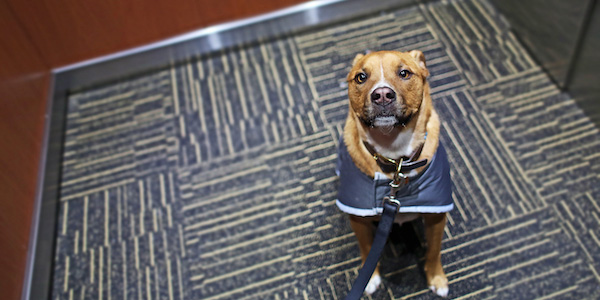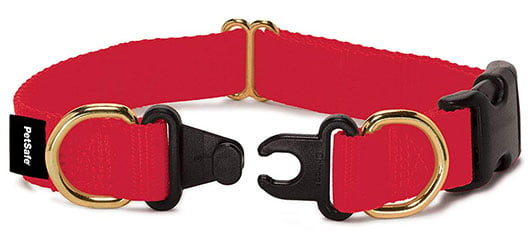 Many dogs have an instinctual fear of moving sidewalks, escalators, and elevators — and for good reason!
Many dogs have an instinctual fear of moving sidewalks, escalators, and elevators — and for good reason!
Escalators and elevators can injure and even kill dogs when accidents happen. While they might be convenient and easy for us humans to navigate, it's best to avoid them altogether when with your furry friend.
While it can be easier to choose the stairs over escalators when with your dog, at times it might be impossible to avoid using an elevator.
You may live in a high-rise apartment building, and climbing multiple flights of stairs throughout the day for potty walks just isn't feasible. First, let's look at the dangers to be aware of and how you can keep your dog safe.
Why Are Escalators Dangerous for Dogs?
With all of the moving parts and the type of materials used in escalators, it's easy for a dog to accidentally become entangled or caught. The escalator can act like a shredder on anything caught in its metal teeth. Serious injuries and even death can occur if paws, nails, fur, or leashes get caught in the grates or between the stationary sides and moving platforms. And these escalator accidents happen far too often.
Many airports and other transportation hubs, along with the San Francisco SPCA, advise that all dogs should be carried on escalators to avoid these accidents, such as this one documented in this video (warning – disturbing footage):
If You Must Take an Escalator with Your Dog
- Familiarize yourself with where the emergency stop button is on the escalator.
- Carry your dog in your arms while you ride the escalator, or have them in a sling or backpack for dogs.
- Be mindful of where your dog's leash is. While holding them in your arms, make sure not to let the leash dangle, as this could cause a tripping hazard or get stuck in the escalator itself.
- If your dog is too large to hold, use an elevator or the stairs.
- Some dogs, such as assistance dogs or seeing-eye dogs, are trained to ride escalators. Training involves staying standing and deftly exiting the escalator or moving walkway by hopping over the grate.
In this video, you can see a large dog who has been trained to be carried up and down escalators:
Dogs and Elevator Danger
The dangerous part of elevators for dogs is while getting on or off. Unfortunately, there are too many heartbreaking stories of dogs who have been injured or killed when they are hung or choked by their collar attached to a leash stuck in elevator doors. And while you might be thinking to yourself, "Those are freak accidents that would never happen to my dog," one of our own team members has witnessed this happen herself. Below are video examples and her story of how dangerous and terrifying a dog getting caught by an elevator can be.
Just being aware of elevator dangers for dogs is the first step to preventing this from happening to more dogs.
Warning – distressing footage
Mia's Experience Helping a Dog Caught in an Elevator
Preventive Vet team member, Mia Horberg, witnessed this same thing happening to a neighbor's dog in their apartment building.
"The incident took place many years ago, but I will never be able to get the images from that night out of my head. I was getting ready to take my dogs out for their last pee before bedtime when I saw one of my neighbors looking very distressed at the very end of the hallway. I asked if he was ok and he shouted, “Help!” I handed the leashes to my partner at the time and ran to see what was happening.
Through tears, he was trying to tell me that as he was trying to get into the elevator, another neighbor and his dog had blocked the entrance and he didn’t realize his dog had made her way into the elevator before the doors closed with her leash still attached to her collar, while he was still holding on to the leash from the other side. The elevator was now stuck, and his poor dog was hanging.
We each grabbed the sides of the elevator doors, trying to pull them apart, but they were too heavy. I knocked on doors and started shouting for help. Thankfully, a few other neighbors came out to see what was happenin,g and each tried to help get the doors apart. Finally, someone brought out something to use as a pry bar — I think it may have been a baseball bat — and as we all pulled the doors apart just a small amount, we saw Lola’s lifeless body dangling from the ceiling.
Thankfully, someone was able to reach in and cut the leash. Her body dropped, her owner let out a wail, and one of our amazing neighbors stepped in to give her CPR. Someone brought out a piece of wood to lay her on and stabilize her. I’m not sure how long it actually took, but it felt like an eternity before Lola started breathing very lightly and slowly started coming back. We got her to my car, and her owner sat with her in the back seat as I rushed them to the nearest emergency vet.
When I got home that night, I burst into tears and didn’t let my dogs out of my arms. I am so grateful to say Lola pulled through and was able to come home after a day or two of being monitored and lived a very happy and healthy ten more years.
It took a long time for me to not have those images in my head on a nightly basis, and I still can’t see a dog by an elevator without thinking about it. Tragedies can happen in a blink of an eye — so I urge you to keep my experience in the back of your mind so every elevator experience is a more mindful one."
How to Make Elevator Rides Safer for Your Dog
Keep Your Dog on a Short Leash When Getting On and Off an Elevator: As the main danger of elevator rides for dogs is if their leash is stuck in the door, keep them very close to you when boarding or exiting an elevator. Hold the entire leash in your hands with just enough length for them to walk right at your side. This way, there isn't any part of the leash that may dangle and get caught in closing doors.
Hold the Elevator Doors During Entry and Exit: Make it a habit of "holding" the elevator door open while you and your dog enter or exit. This gives you an extra way to make sure your dog and their leash are fully inside or outside of the elevator before the doors close.
Consider a Breakaway Collar: If you and your dog ride elevators frequently, consider having them wear a breakaway collar for elevator rides. These collars are designed to unclip when pressure is applied to prevent choking. Because of this quick breakaway action, I don't recommend these collars for regular leashed walks, but you can simply switch the leash to just one D-ring on the breakaway collar before entering the elevator and then switch back to their harness after exiting.
Be Aware: Keep your dog focused on you while riding the elevator, so they don't take the opportunity to follow someone else out the doors and leave you behind holding the leash. It can be very helpful to have them sit right next to you or even in between your legs to ensure they are in a safe position and not wandering around. On the flip side, don't get distracted by checking your phone while riding the elevator – keep an eye on your pup and praise them for being such a good dog!
Carry Small Dogs While Riding Elevators: Smaller dogs can move fast and can be hard to see in a crowded elevator. It's safest to keep them in your arms while riding the elevator.
Be Prepared: In case you witness an elevator accident like this, it can be helpful to know pet first aid. Familiarize yourself with where the emergency stop button is on an elevator.
Spread Awareness: The more people who know about these dangers for dogs, the more we can prevent tragic accidents from happening. If you live in an apartment building with elevators, ask management to post a safety warning at the elevators for dog owners or share this article with other dog owners in the building.
If your dog has had an injury or incident from an elevator or escalator and hasn't been to the veterinarian since they seemed to recover, we suggest you get them checked out. It's always important to have a vet examine a pet after any trauma.





